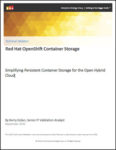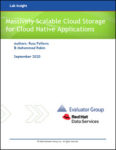This ESG Technical Validation documents remote testing of Red Hat OpenShift Container Storage with a focus on the ease of use and breadth of data services. Containers have become an important part of data center modernization. They simplify building, packaging, and deploying applications, and are hardware agnostic and designed for agility—they can run on physical, virtual, or cloud infrastructure and can be moved around as needed.
Simplifying Persistent Container Storage for the Open Hybrid Cloud
Massive Scalable Cloud Storage for Cloud Native Applications
In this comprehensive technology white paper, written by Evaluator Group, Inc. on behalf of Lenovo, we delve into OpenShift, a key component of Red Hat’s portfolio of products designed for cloud native applications. It is built on top of Kubernetes, along with numerous other open source components, to deliver a consistent developer and operator platform that can run across a hybrid environment and scale to meet the demands of enterprises. Ceph open source storage technology is utliized by Red Hat to provide a data plane for Red Hat’s OpenShift environment.
IBM Announces New AI Hardware Research, Red Hat Collaborations
At the IEEE CAS/EDS AI Compute Symposium, IBM Research introduced new technology and partnerships designed to dynamically run massive AI workloads in hybrid clouds: The company said it is developing analog AI, combining compute and memory in a single device designed to alleviate “the von Neumann bottleneck,” a limitation resulting from traditional hardware architectures in […]
PSSC Labs Announces CBeST Cluster Management Software Stack v5 Release with Red Hat Support
Lake Forest, CA , Oct. 13, 2020 — PSSC Labs, a developer of high performance computing (HPC) and big data computing solutions, announces today that a new release of CBeST Cluster Management v 5.0 Software Stack will be available. The newest version of CBeST will add support for the latest Red Hat Enterprise Linux / […]
IBM Launches 7nm POWER10 CPU
IBM today announced a new IBM POWER10 CPU family, its first 7nm form factor platform, built with Samsung, designed for enterprise hybrid cloud computing with up to 3x greater processor energy efficiency, workload capacity, and container density than its predecessor, according to the company. According to IBM, POWER10 highlights include: Support for multi-petabyte memory clusters […]
Supermicro Powers Red Hat Hyperconverged Infrastructure for Virtualization
Today Supermicro introduced multiple systems tailored to work with a leading open, hyperconverged software offering, Red Hat Hyperconverged Infrastructure. Supermicro collaborated with Red Hat to develop advanced configurations based on industry-leading Supermicro servers featuring the latest technologies. These systems, available now, give customers new options when architecting infrastructure.
Simplifying NVIDIA GPU Driver Deployment on Red Hat Linux
Over at the NVIDIA blog, Pramod Ramarao writes that NVIDIA and Red Hat have worked closely to improve the user experience when installing and updating NVIDIA software on RHEL, including GPU drivers and CUDA. “The NVIDIA / Red Hat partnership continues to grow and there are many integration efforts across Red Hat’s and NVIDIA’s product portfolios on projects as diverse as video drivers, heterogeneous memory management (HMM), KVM support for virtual GPUs, and Kubernetes.”
Red Hat Teams with NVIDIA to Accelerate Machine Learning in the Cloud
Today Red Hat announced it has deepened its alliance with NVIDIA to accelerate the enterprise adoption of AI, machine learning and data analytics workloads in production environments. To move thins along, Red Hat is launching an early access program for prospective customers. “High-performance technologies are moving at a brisk rate into enterprise data centers to accelerate product development and business operations – including financial services, ERP and sales analysis, fraud detection and cybersecurity, and machine learning-AI,” said Steve Conway, senior vice president of research, Hyperion Research. “The hybrid cloud solutions from Red Hat and NVIDIA are designed to make accelerated computing use easier for enterprises on-premise and in the cloud.”
Video: OpenHPC Update
Adrian Reber from Red Hat gave this talk at the FOSDEM’19 conference. “In this talk I want to give an introduction about the OpenHPC project. Why do we need something like OpenHPC? What are the goals of OpenHPC? Who is involved in OpenHPC and how is the project organized? What is the actual result of the OpenHPC project? It also has been some time (it was FOSDEM 2016) since OpenHPC was part of the HPC, Big Data and Data Science devroom, so that it seems a good opportunity for an OpenHPC status update and what has happened in the last three years.”
Red Hat Steps Up with HPC Software Solutions at SC18
In this video from SC18 in Dallas, Yan Fisher and Dan McGuan from Red Hat describe the company’s powerful software solutions for HPC and Ai workloads. “All supercomputers on the coveted Top500 list run on Linux, a scalable operating system that has matured over the years to run some of the most critical workloads and in many cases has displaced proprietary operating systems in the process. For the past two decades, Red Hat Enterprise Linux has served as the foundation for building software stacks for many supercomputers. We are looking to continue this trend with the next generation of systems that seek to break the exascale threshold.”












